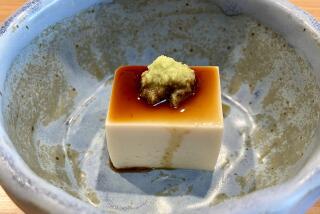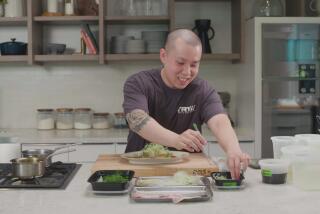Tofu Takes On the Mainstream Market : Trends: The albino Jell-O is not longer just for vegetarians.
- Share via
Remember tofu? The bland, curdy stuff that looks like albino Jell-O, beloved by your vegetarian friends?
If you think that bean curd is only for Asians and health food fanatics, it’s time to look again. Tofu is turning up at mainstream markets and top restaurants. My local supermarket recently began carrying tofu with Chinese spices and even one with French herbs.
There’s good reason for tofu’s new-found popularity. In this age of reduced meat consumption, tofu offers easily digestible protein without harmful fats or cholesterol. Tofu contains all eight essential amino acids. Its low calorie count (147 calories in an eight-ounce serving) is a boon to dieters. Tofu is an excellent source of calcium, but without the sodium and saturated fat of cheese. It’s also an ecological food: an acre of soybeans provides 20 times as much usable protein as an acre used by cattle for grazing.
Tofu was invented in China, where it has been a dietary mainstay for 2,000 years. The Japanese are avid tofu consumers, as are Koreans and Southeast Asians. Once limited to Asian markets, tofu can now be found in the produce section of any major supermarket.
Tofu is also known as bean curd; the dairy metaphor is apt. To make it, fresh soybeans are soaked overnight, finely ground, and cooked with water to make soy milk. The soy milk is then separated into “curds” and “whey,” using one of two natural coagulants: nigari (magnesium chloride extracted from sea water) or calcium sulfate (naturally mined gypsum). Tofu made with the latter is higher in calcium. The curds are then strained and pressed into the familiar ivory-colored, cobblestone-shaped cakes.
In the Orient there are literally dozens of types of tofu and tofu by-products, including malodorous fermented tofu and crepe-like bean curd skins. In this country, you’ll find four basic types: extra-firm, firm, soft and silken. Extra-firm and firm tofu are intended for grilling, pan-frying, stir-frying and other preparations in which you want the bean curd to retain its shape. Soft tofu is great for cheese cakes and salad dressings, while silken tofu has a soft custardy consistency well suited to soups and desserts.
In the old days, buying tofu required fishing around in a water-filled tub at an Oriental market. (If you do buy it in bulk, be sure the packing liquid is clean and free of unpleasant odors.) Today, tofu is commonly sold in 1-pound blocks in convenient plastic containers. Refrigerate it until using and use by the date on the container. Once the package is opened, store the tofu in water to cover, changing the water daily. Use open bean curd within a week.
Few foods are more versatile: tofu can be broiled, baked, steamed, stir-fried, scrambled and whipped into creamy sauces. It is equally at home in a fiery Sichuan stir-fry, a soothing Japanese soup, a New Age salad dressing and a non-dairy cheese cake. Tofu’s detractors decry what they call its blandness. I prefer to think of its flavor as delicate and faintly nutty--a perfect foil for sauces, spice mixtures and herbs.
Rinse tofu thoroughly with cold water before using. If a firm consistency is desired, press the tofu between a plate and a heavy pot for 1 hour. Freezing gives tofu a concentrated, chewy, almost meat-like texture: freeze it for at least 24 hours. Once thawed, the tofu should be cut into slices and squeezed between your palms to extract the water.
Tofu can also be crumbled and sauteed, like scrambled eggs, and marinated and grilled, like teriyaki. You can make a variety of dips, sauces and salad dressings by pureeing tofu in a blender with flavorings, vinegar or lemon juice, and oil.
The classic Sichuan tofu dish is guaranteed to make believers of skeptics and critics. Albino Jell-O, indeed!
Ma Po Tofu supposedly takes its name from a woman named Mrs. Chan, who had a bad complexion. (Ma is Chinese for “pock mark.”) The heat of the chiles and peppercorns contrasts with the mildness of the bean curd. Traditionally, Ma Po Tofu is made with soft tofu, but it is also good with firm.
MA PO TOFU
(Sichuan-Style
Bean Curd
With Pork)
1 pound fresh tofu
3 ounces lean pork
1-inch piece ginger root
2 cloves garlic
1 to 2 hot chiles
4 green onions
2 tablespoons oil
Sauce
1 1/2 teaspoons cornstarch
1 tablespoon water
1 teaspoon Sichuan peppercorns, lightly toasted and ground
Rinse tofu and cut into 1/2-inch cubes. Chop pork as finely as possible. Mince ginger, garlic and chiles (for spicier dish leave chile seeds in). Mince white part of green onions and thinly slice green part diagonally.
Heat wok over high heat and swirl in oil. Add ginger, garlic, chiles and white part of green onions. Stir-fry 30 seconds or until fragrant. Add pork and stir-fry 1 minute, or until meat changes color. Add tofu and stir-fry 30 seconds. Stir in Sauce and bring to boil.
Reduce heat and gently simmer mixture 5 minutes. Dissolve cornstarch in water. Stir mixture into tofu and cook 30 seconds. Correct seasonings, adding soy sauce, chile paste, or sugar to taste. Transfer tofu mixture to platter or plates and sprinkle with remaining chopped green onions and Sichuan peppercorns.
Makes 4 appetizer servings or 2 to 3 entree servings.
Sauce
1 cup chicken stock or water
3 tablespoons soy sauce
2 tablespoons rice wine or Sherry
1 tablespoon rice wine vinegar (or distilled white vinegar)
2 teaspoons sesame oil
1 teaspoon Chinese chile paste or hot sauce
1/2 teaspoon sugar
Combine stock, soy sauce, rice wine, rice wine vinegar, sesame oil, chile paste and sugar in bowl. Mix well.
More to Read
Eat your way across L.A.
Get our weekly Tasting Notes newsletter for reviews, news and more.
You may occasionally receive promotional content from the Los Angeles Times.










